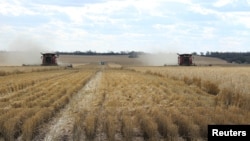Some weather experts are predicting hot, dry weather in Asia, while the United States is expected to receive heavier rainfall.
The predictions are linked to the effects of a warm Pacific Ocean current known as El Niño that is expected to develop in the coming months.
El Niño is a warming of surface water temperatures in the eastern and central Pacific Ocean. The event usually causes hot, dry weather in Asia and Australia. It can also lead to heavier rain in the southern U.S. and southern parts of South America.
Weather experts say El Niño is likely to reduce wheat production in Australia. The country is one of the world’s largest wheat exporters. El Niño is also expected to hurt palm oil and rice production in Indonesia, Malaysia and Thailand.
"We are looking at longer term dryness in Australia from now until at least August," said Chris Hyde. He is a meteorologist at U.S.-based technology company Maxar. "The seasonal outlook in India is a weaker than normal monsoon for the entire country, extending into Pakistan," Hyde said.
Lower Asian production of grains and oilseeds linked to El Niño is expected to increase concerns about rising food prices for some of the world's most vulnerable people, Reuters news agency reported. Even if the event increases crop production in the Americas, effects in Asia might be felt in the world food markets.
Wheat prices recently dropped to their lowest levels in two-and-a-half years. Corn and soybean prices have also eased since 2022. That is when the Russia-Ukraine war and COVID-19 affected world supplies.
The start across South Asia of seasonal rains, known as monsoons, is likely to be delayed somewhat this year, weather experts told Reuters. El Niño could also affect rice and oilseed production.
O.P. Sreejith is a scientist with the India Meteorological Department. He told Reuters that El Niño could develop during July and continue into the second half of the season. However, Sreejith said India could get lucky with a weak El Niño, as higher sea-surface temperatures in the Indian Ocean and southwesterly winds could bring more rains.
Dry conditions in the United States and Argentina have reduced wheat and soybean crops this year. Heavier rain in the second part of the season could be good for crops. But some experts noted that results will depend on the timing of El Niño.
Meteorologists are divided over how soon the ocean currents will change to El Niño and how this will affect U.S. weather. But the change should be complete during the important growing period for corn and soybeans.
"I think the growing conditions are going to be pretty good," said David Tolleris, president of weather prediction service WxRisk.
El Niño is likely to help increase soil moisture in the U.S. Plains – an area stretching through the middle of the country. This could mark the beginning of a much-improved winter wheat harvest in 2024, weather experts said.
I’m Bryan Lynn.
Reuters reported this story. Bryan Lynn adapted the report for VOA Learning English.
_______________________________________________________
Words in This Story
meteorologist – n. someone who studies weather, especially to provide predictions
vulnerable – adj. easy to hurt or attack physically or emotionally
moisture – n. small drops of water existing in the air or on the surface
__________________________________________________________
What do you think of this story? We want to hear from you. We have a new comment system. Here is how it works:
- Write your comment in the box.
- Under the box, you can see four images for social media accounts. They are for Disqus, Facebook, Twitter and Google.
- Click on one image and a box appears. Enter the login for your social media account. Or you may create one on the Disqus system. It is the blue circle with “D” on it. It is free.
Each time you return to comment on the Learning English site, you can use your account and see your comments and replies to them. Our comment policy is here.









Forum